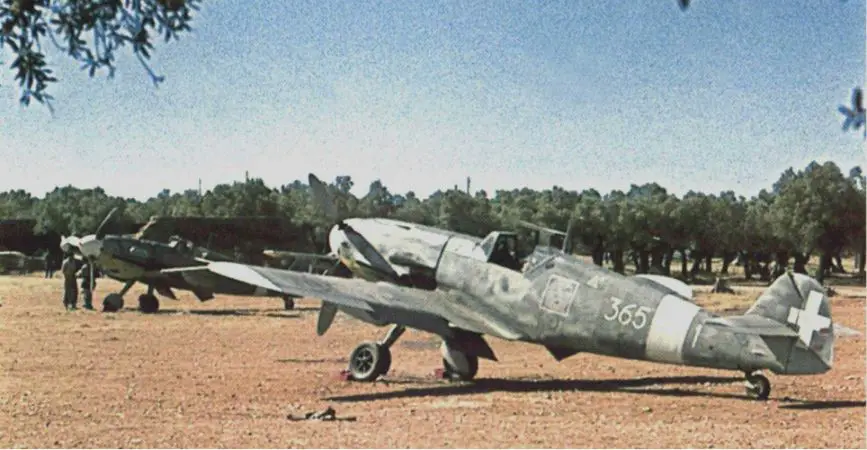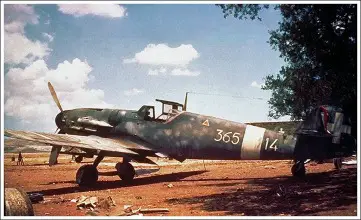
During WW2, the Italian Regia Aeronautica put in service a not negligible number of German built aircraft, most notably Ju87 dive bombers, but also Bf109 and also some two engine bombers.
German-Italian exchanges
Before the start of the war, the German Luftwaffe organized a couple of “missions” in Italy, aimed at showing and promoting the best samples of the aircraft industry. Some pilots and higher officers were impressed by the German machines, but this did not materialize in the purchase of foreign-built fighters or bombers. However, the Italians saw the need to develop a new generation of fighter aircraft but since the local industries were not able to produce very powerful engines, it was decided to buy the license for building the Daimler Benz engines DB 601. Such an engine would have later equipped the M.C. 202 and the Re. 2001. After the first war experiences, the Italians realized that most of their aircraft were not up to the standards of modern war and thus tried to fill the gap by developing new designs and acquiring German-built aircraft. This article provides an overview of the main types of German aircraft used by the Italian Air Force (Regia Aeronautica).
Fieseler “Storch”
The little recognisance aircraft Fi.156 Storch, capable of taking off and landing in very short spaces, was very much appreciated by the Italians. In 1938, Reichsmarshall Goering gifted Italo Balbo (then Governor of Libya) with one such aircraft. Gen. Fougier, commanding the Italian air group deployed in the Battle of Britain (Corpo Aereo Italiano) also got one in 1940.
By the end of that year, the Italians requested the Germans a first batch of Fi.156 to be used for connection duties across the various fronts. In total, until September 1942, the Regia Aeronautica received around 3 “Storch” that was used in Italy, Albania, Greece, Libya, Yugoslavia and Russia.

Fi 156 of the Regia Aeronautica
Ju. 87 “Stuka”
Perhaps the German aircraft that saw the most intense use in the Regia Aeronautica was the famous Ju. 87 “Stuka” dive bomber. I have talked extensively in another article about this aircraft and its use in an Italian hand, here I will limit myself to recall that the purchase of the first batch of “Stukas” came in the second half of 1940, when the Regia Aeronautica touch with hand the failure of the S.M.85 and thus began the acquisition of the German bomber. Around 150 aircraft (of 3 versions) were used by the Italians on all fronts around the Mediterranean.

Italian Stukas
Dornier 217
The need to acquire a heavily armed aircraft suitable for night-time interception against allied bombers, brought the Regia Aeronautica in 1942 to request a batch of Bf.110 heavy fighters to the Luftwaffe. These aircraft were neglected and instead, the Germans transferred a small group of Dornier 217 N, two-engine bombers modified to serve as night fighters. A total of 14 Do 217 N were given to the Italians and became operational towards the end of 1942.
The small number of aircraft received could not form a consistent countermeasure against the Allied bombing offensive only two victories were scored by the Italian Dorniers. By the time of the armistice between Italy and the Allies (September 1943), only 9 Do.217 were still operational and the Germans managed to capture them and put them back in service with the Luftwaffe.
Ju. 88
Towards the end of 1942, the Regia Aeronautica saw the need to fill the ranks of its bomber force with new modern twin-engine bombers built by Germany, since no new Italian aircraft of such kind were available. An agreement with the Luftwaffe sought the progressive transfer of Junkers Ju. 88 bombers and Italian pilots began training on the new machines in March 1943. Training of pilots and the transfer of the promised aircraft proceeded slowly and by the time of the armistice, around 50 Ju. 88 were in service with the Regia Aeronautica. None of them saw action with the Italians and were almost all captured on their airfields by the Germans after the 8th of September 1943.

Ju.88 of the Regia Aeronautica in an Italian airfield
Bf 109
The Italian pilots that participated in the battle of Britain (as part of the C.A.I) were able to closely observe the qualities of the Bf 109, especially if compared to their outdated Fiat G.50 and C.R.42. After the disbandment of the C.A.I., a bunch of pilots of the 20° Group, flying on the G.50 were authorized by the Germans to familiarize and train on the Bf 109 E, in bases in occupied France.
The training roughly lasted from November 1940 to April 1941 and ended when the Germans refused to transfer a certain amount (a source says 100) of Bf109 F to the Regia Aeronautica.
The war progressed and the attrition on the fighter fleet of the Regia Aeronautica was so severe that in early 1943, the Luftwaffe, through Kesserling himself, ordered the transfer of around 100 Bf 109 G. New pilots began the training and by the time of the allied landings in Sicily, 61 German fighters were operational in the ranks of the Regia Aeronautica.

B109 G in Sicily
However, the overwhelming air superiority of the Allies and the intense bombing campaign against Axis airfields meant that most of the fighters were destroyed on the ground. The few surviving aircraft saw brief action over Sicily and then were withdrawn in mainland Italy, mostly in airfields around Rome.
After the armistice, more BF 109 G equipped the newly born Air Force (Aeronautica Nazionale Repubblicana – ANR) of the Italian puppet state in the north of Italy. These fighters constituted the bulk of ANR’s squadrons alongside Fiat G.55 and a few M.C.205.
Sources
Arena, N. (1978). La Luftflotte Italiana: Gli aerei tedeschi edll’aeronautica italiana nella seconda guerra mondiale.
Guglielmetti, L., & Rebora, A. (2014). La Regia Aeronautica nella Battaglia d’Inghilterra.
Lembo, D. (1999). I tuffatori della Regia. Aerei nella Storia , 30-38.
Marcon, T. (1999). I tuffatori della Regia Aeronautica. Storia Militare n.66, 16-33.
Sgarlato, N. (2000). La Regia Aeronautica nella II Guerra Mondiale. Delta Editrice.